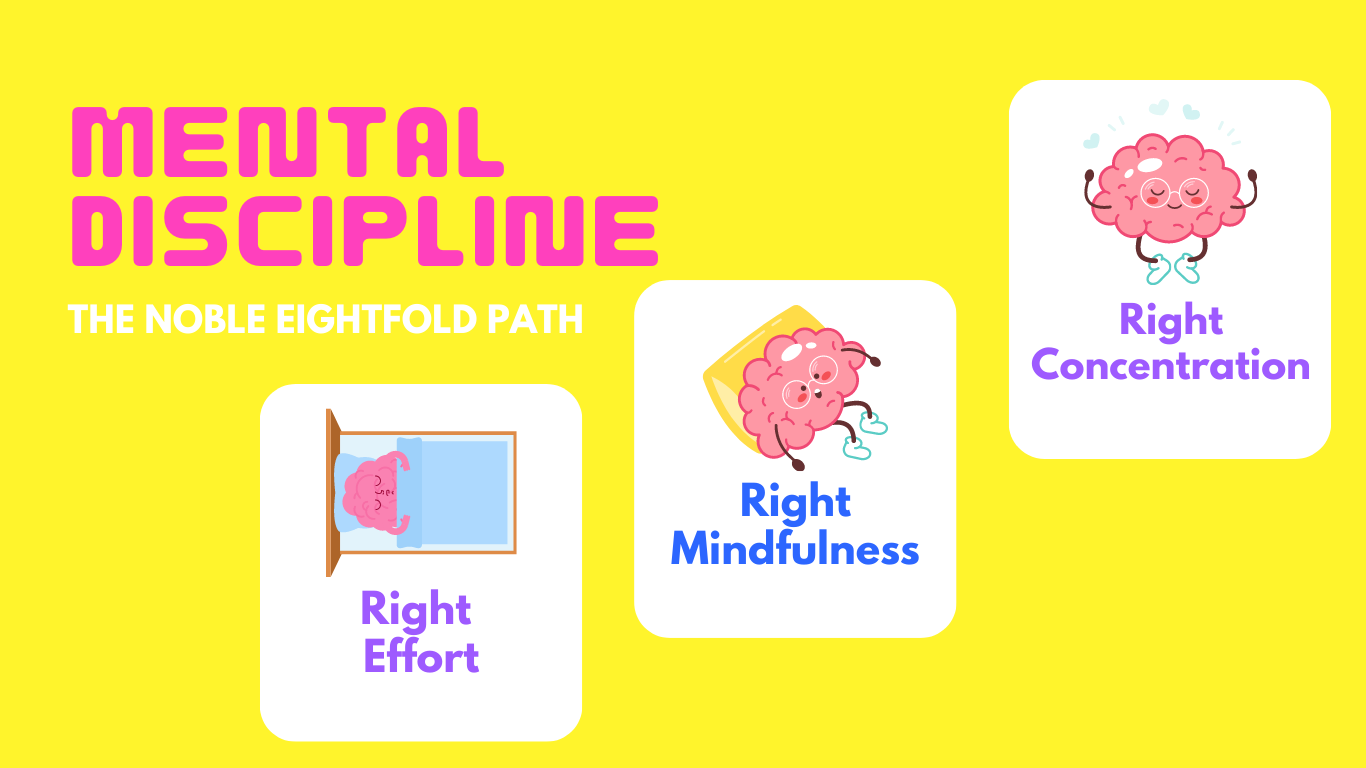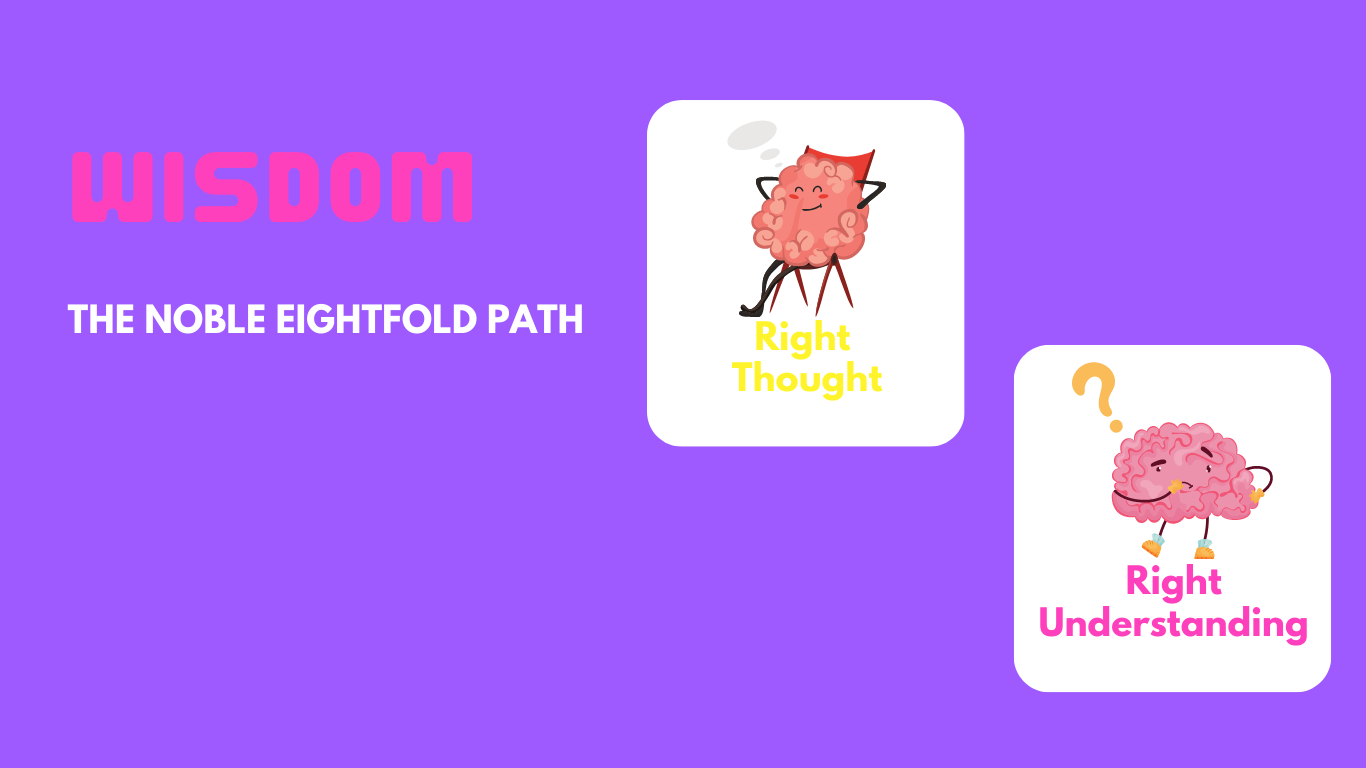The Eightfold Path consists of eight areas of practice that encompass all aspects of life, which were taught by the Buddha in his first sermon after enlightenment.
Although they are numbered from one to eight, they are not meant to be ‘mastered’ one at a time but rather practiced all at once. Every aspect of the path supports and reinforces every other aspect.
In Buddhism, the Eightfold Path is intended as a guideline to be considered, contemplated, and embraced only when each step is wholeheartedly accepted as an integral part of the life one seeks.
The symbol of the Path is the eight-spoke dharma wheel, with each spoke representing an area of practice. As the wheel turns, who can say which spoke is first and which is last?
The Noble Eightfold Path, as laid down by the Buddha, assists individuals in attaining the state of Nirvana by liberating them from attachments and delusions, allowing them to comprehend the intrinsic truth of all things. This path facilitates ethical and mental growth and development, guiding individuals toward understanding and enlightenment. The Buddha explained the path in various ways and used different words when addressing different people, tailoring his teachings to match their developmental stage and capacity for understanding and following his guidance.
THE NOBLE EIGHTFOLD PATH
- Right understanding/Right View (Samma ditthi)
- Right thought (Samma sankappa)
- Right speech (Samma vaca)
- Right action (Samma kammanta)
- Right livelihood (Samma ajiva)
- Right effort (Samma vayama)
- Right mindfulness (Samma sati)
- Right concentration (Samma samadhi)
The eight parts of the path to liberation are grouped into three essential elements of Buddhist practice—moral conduct, mental discipline, and wisdom.
To practice the Noble Eightfold Path is to train in three areas of discipline: wisdom, ethical conduct, and mental discipline.

Right Speech
Moral Discipline
Right Speech, also known as Wise Speech or Virtuous Speech, refers to speech that fosters peace and happiness in oneself and others.
Right speech entails abstaining from:
1. Telling lies
2. Backbiting, slander, and speech that may incite hatred, enmity, disunity, and disharmony among individuals or groups
3. Using harsh, rude, impolite, malicious, or abusive language
4. Engaging in idle, useless, and foolish babble and gossip.
By reframing these principles positively, they encourage us to speak the truth, promote harmony among people, use a friendly and benevolent tone, and speak mindfully to ensure our words are meaningful and purposeful. We should also consider the timing and context of our speech. If we cannot contribute something useful, it’s best to maintain “noble silence.”
Right Speech is a practice of mindfulness. Mindfulness enables us to recognize what we are about to say before we say it, granting us the freedom to choose when, what, and how to speak. Through mindfulness, we discern that our speech originates from the heart. We learn to control our speech in moments of anger, hostility, or confusion, and over time, we train the heart to incline towards positive qualities such as love, kindness, and empathy. From these qualities, Right Speech naturally emerges.
Right Action
Ethical conduct
- Not stealing
- No killing
- Not misusing sex
- Not lying
- Not abusing intoxicants
Not killing literally means ‘not to take life under any circumstances throughout the universe, with no exceptions.’ No form of intentional killing is permitted, either directly or indirectly.
There may be times when the practice seems to come with effortless ease, for example, when you feel no impulse to kill.
On the other hand, when you are hurt, you may lose all patience and actually think of killing another human being. At that time, you violate the precept in terms of mental action: the karma of thought.
What about more subtle cases, where we implicitly or indirectly support others to kill, such as allowing our government’s military activities or capital punishment? Is this in accord with the conventional meaning of this bodhisattva precept? No, it is not. One who lives for the welfare of all beings may in no way willingly support or be a condition for any killing.
Killing is the most extreme expression of ignorance. It is a radical turning away from the true meaning of life and death. Killing shows disrespect for the miracle of all life.
If we accept in our hearts this strict interpretation of the precept, we may come to share a feeling of responsibility for the killing that is happening worldwide. Despite our grief about and opposition to such killing, we may still see that in fact, we are a part of it.
Right Action’ is about ‘right’ morality—translated as samyak or samma. It means being accurate or skillful and carries connotations of ‘wise,’ ‘wholesome,’ and ‘ideal.’ It is ‘right’ in the sense of being ‘upright,’ like a ship that rights itself when battered by a wave.
Right Livelihood
Moral Conduct
Right livelihood means abstaining from making a living through a profession that brings harm to others, such as trading in arms and lethal weapons, intoxicating drinks, poisons, killing animals, cheating, etc. It entails living by a profession that is honorable, blameless, and innocent of harm to others. One can clearly see that Buddhism strongly opposes any kind of war when it asserts that the trade in arms and lethal weapons is an evil and unjust means of livelihood.
If we are embarking on a spiritual path, we need to live our lives ethically. This means ensuring that we do as little harm as possible to anyone or anything while earning our daily bread.
We cannot distance ourselves from our connection to the rest of the world, as it guarantees our existence. If we have a ‘good job’ and yet refuse to consider where our food comes from, what happens to the plastic, why gas can be so cheap, and so on, our spiritual practice will be undertaken with eyes wide shut.

Right effort
Mental Discipline
Right Effort entails maintaining a positive attitude and approaching tasks with enthusiasm and cheerful determination. We need to strike a balance, avoiding both excessive intensity and complacency in our work.
It also entails steering clear of unwholesome thoughts. It’s akin to “right action” for the mind. Right Effort involves:
- The effort to prevent unwholesome qualities—especially greed, anger, and ignorance—from arising.
- The effort to extinguish unwholesome qualities that have already arisen.
- The effort to cultivate skillful, wholesome qualities—especially generosity, loving-kindness, and wisdom (the opposites of greed, anger, and ignorance)—that have not yet arisen.
- The effort to strengthen the wholesome qualities that have already arisen.
The Five Hindrances
When contemplating Right Effort, it’s also important to consider the Five Hindrances from the Nivarana Sutta of the Pali Canon. These are:
- Sensual desire (kamacchanda)
- Ill will (vyapada)
- Sloth, torpor, or drowsiness (thina-middha)
- Restlessness and worry (uddhacca-kukkucca)
- Uncertainty or skepticism (vicikiccha)
These five qualities can obstruct Right Effort. The Buddha taught that mindfulness—of body, sensations, feelings, and thoughts—can overcome these hindrances.
Right Mindfulness
Mental Discipline
What Is Mindfulness?
The Pali word for ‘mindfulness’ is ‘sati,’ which conveys meanings like ‘retention,’ ‘recollection,’ or ‘alertness.’
Mindfulness represents a holistic awareness of the present moment encompassing both body and mind. To be mindful is to be fully present, free from daydreams, anticipation, indulgence, or worry.
Additionally, mindfulness entails observing and relinquishing the thought patterns that uphold the illusion of a separate self. Complete mindfulness involves being fully attentive to everything as it is, without filtering experiences through our subjective opinions. This involves letting go of the habit of judging everything based on personal preferences.
Meditation plays a significant role in cultivating mindfulness. It is practiced in various Buddhist schools as a part of mental development. The Sanskrit term for meditation, ‘bhavana,’ translates to ‘mental culture,’ and all forms of Buddhist meditation incorporate mindfulness.
Four Frames of Reference
The Buddha stated that there are four frames of reference in mindfulness:
- Mindfulness of the body (kayasati).
- Mindfulness of feelings or sensations (vedanasati).
- Mindfulness of the mind or mental processes (cittasati).
- Mindfulness of mental objects or qualities (dhammasati).
Right concentration
Mental Discipline
In the context of Buddhism, the term ‘Right’ originates from the Pali word ‘samma,’ embodying notions of thoroughness, harmony, and completeness. ‘Concentration,’ derived from ‘samadhi,’ signifies collectedness, calmness, and unification. Engaging in the practice of right concentration entails cultivating a harmonious alignment of the mind with the other facets of the noble eightfold path.
This alignment assumes significance since every component of the path complements and interconnects with the rest. It’s akin to positioning dominos in a sequence or assembling puzzle pieces; the effectiveness of right concentration hinges on the synergy of all path factors.
So, how do we practically engage in right concentration? In essence, we aim to attenuate hindrances by calming the mind. These hindrances encompass greed, ill will, restlessness, dullness, and confusion. As these hindrances diminish, it’s akin to a fog lifting from our perception, drawing us closer to ‘yathabhuta,’ the genuine understanding of reality.
At the core of concentration meditation lies the art of letting go—releasing the mental clutter and obscurity—enabling the mind to find repose. This is why breath meditation proves invaluable. Through this practice, we permit the mind to relax in the presence of the breath, facilitating stillness and tranquility. This tranquility then naturally evolves into a focused and clear awareness.

Right Understanding
The Wisdom Path (Prajna)
Right Understanding is also sometimes referred to as Right View. It provides insight into the nature of things as they are, particularly focusing on the first three Noble Truths—the nature of dukkha, the cause of dukkha, and the cessation of dukkha (dukkha – suffering).
In Buddhism, two types of understanding are recognized. What we commonly refer to as ‘understanding’ is knowledge—an accumulation of memory and an intellectual grasp of a subject based on certain given data. This is termed ‘knowing accordingly’ (anubodha), which isn’t very deep. True deep understanding or ‘penetration’ (pativedha) involves perceiving something in its true nature, free from names and labels. Such penetration becomes possible only when the mind is liberated from all impurities and has been fully developed through meditation.
The Buddha repeatedly emphasizes the need to reflect on our thoughts, as thoughts lead to actions. He reminds us that incorrect views lead to erroneous decisions, which further result in misguided speech and actions, culminating in unfavorable outcomes.
Right Thought
The Wisdom Path (Prajna)
The Buddha taught us that our thoughts are very powerful; they determine our mental states, such as happiness or sadness, and subsequently guide our actions.
There are three fundamental stages to Right Thought: firstly, becoming aware of our thinking process; secondly, letting go of negative thought patterns; and thirdly, cultivating goodwill.
As we investigate our thoughts, we can ask ourselves the following questions: ‘Are these thoughts benefiting me and others?’ ‘Do they stem from kindness or desire?’ ‘Are my thoughts serving my heart?’ ‘Do they connect me with life or separate me from it?’ We can also try saying out loud, ‘No, I will not follow this negative thought. I call on my inner resources to resist it.’ Faced with such determination, thoughts tend to dissipate and reveal their impermanent nature.
As we begin meditation practice, it is challenging to resist the temptation of following thought storylines, especially when they involve pleasant or unpleasant dramas. Such thoughts tend to cling, as we easily become attached to them and forget to return to the less exciting focus of the breath.
Once we become aware of our thinking process, we can practice observing thoughts as they arise, moving like clouds across the spaciousness of the mind, and passing away. We learn that we have a choice about whether or not to engage in thoughts.
In the second stage of developing Right Thought, we do not aim to stop thinking, but we strive to renounce or let go of habitual and inappropriate thoughts that do not support our wellbeing.
In the third stage of Right Thought, we can cultivate joy, appreciation, and gratitude through prayer or by focusing on counting our blessings and appreciating the qualities of those we love.
Generalizations and stereotypes cloud our thinking, preventing us from perceiving things as they truly are. Right Thought involves approaching every person and situation as new and unique. When we enter a new situation with a negative attitude, the outcomes are often negative. Anger also distorts our perceptions. Right Thought teaches us to view things with a calm mind, one that resides in the present moment without carrying the burdens of the past. Today’s world serves as a prime example of the necessity for Right Thought. We must not allow our anger or the misguided actions of a few extremists to distort our view of any race, nationality, or religion.
From this concise portrayal of the noble eightfold path, it becomes apparent that it presents a lifestyle to be embraced, honed, and refined by every individual. It embodies self-control in actions, speech, and thoughts—a journey of personal growth, enhancement, and purification.
The Noble Eightfold Path serves as a Guideway toward attaining the comprehension of Ultimate Reality, reaching full liberation, contentment, and serenity through the mastery of moral, spiritual, and cognitive excellence.



